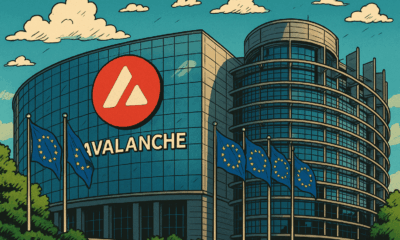Altcoins
Avalanche Defies the Crypto Downturn with a 10% Surge — Here’s What’s Fueling AVAX’s Rally

- Share
- Tweet /data/web/virtuals/383272/virtual/www/domains/theunhashed.com/wp-content/plugins/mvp-social-buttons/mvp-social-buttons.php on line 63
https://theunhashed.com/wp-content/uploads/2025/09/avax-1000x600.png&description=Avalanche Defies the Crypto Downturn with a 10% Surge — Here’s What’s Fueling AVAX’s Rally', 'pinterestShare', 'width=750,height=350'); return false;" title="Pin This Post">
In a week when most of the crypto market struggled to keep its footing, Avalanche stood out like a beacon in the fog. As Bitcoin and Ethereum took a hit, Avalanche’s native token, AVAX, surged by 10 percent, defying bearish sentiment and drawing attention across the industry. The sudden momentum isn’t just a random blip — it’s the product of coordinated institutional efforts, strategic protocol upgrades, and promising on-chain fundamentals that paint a very different picture from the rest of the market.
Swimming Against the Current
The broader crypto market has recently faced macroeconomic headwinds, ranging from regulatory uncertainty to global risk-off sentiment, leading to widespread losses across major tokens. But Avalanche bucked the trend. AVAX’s double-digit gain not only surprised analysts but also challenged the notion that all altcoins must move in tandem with Bitcoin’s price action. So what sets Avalanche apart at this particular moment?
A major catalyst comes from the Avalanche Foundation’s strategic push to attract institutional capital. The Foundation is preparing to raise a massive $1 billion through two U.S.-based investment vehicles that will purchase AVAX tokens directly from its treasury. These vehicles are backed by serious players — one led by Hivemind Capital, and another linked to a special purpose acquisition company involving Dragonfly Capital. The structure is designed to offer institutional investors discounted access to AVAX, potentially unlocking new sources of demand while limiting downside volatility through direct treasury management.
Institutional Inroads and Retail Momentum
The interest in Avalanche isn’t limited to private capital vehicles. Public investment products are also coming online. Sweden-based Vitune recently launched a crypto exchange-traded product (ETP) specifically tailored to AVAX. Meanwhile, global investment firm VanEck has filed to launch an Avalanche-focused exchange-traded fund (ETF), joining Grayscale, which is expanding its Avalanche Trust offering. These moves are more than symbolic — they signal a maturing ecosystem that is becoming increasingly accessible to both institutional and retail investors.
Yet, capital inflows alone don’t sustain token value without technical progress. In April, Avalanche implemented the “Durango” network upgrade, a key part of which was the rollout of “Teleport” and the introduction of Avalanche Warp Messaging to make cross-chain communication more seamless. Alongside this, the C-Chain’s Octane upgrade dramatically slashed transaction fees — by some estimates, as much as 98 percent — making the network more scalable and user-friendly. As a result, Avalanche has seen a meaningful uptick in user engagement and transaction volume.
Daily transaction counts have risen sharply, with activity levels reaching around 1.4 million per day by the second quarter. The number of active addresses jumped by 57 percent, and Avalanche’s Total Value Locked (TVL) doubled from just over $1 billion to more than $2.2 billion. Perhaps even more telling is the explosive growth in its stablecoin market cap, which expanded by 81 percent in just 30 days. These figures point to a strengthening ecosystem that’s not merely propped up by speculation, but by increasing on-chain utility and user adoption.
The Technicals: Signals from the Chart
From a technical analysis standpoint, AVAX appears to be forming a rounded bottom — a chart pattern often associated with long-term accumulation and eventual breakout. If the token can decisively breach resistance at around $36, it could validate this bullish formation and open the door to further gains.
Analysts are eyeing two main price targets. The more conservative is around $55, representing a key neckline resistance level from previous market cycles. A more aggressive, long-term projection based on the measured move from the rounded bottom points toward $212, a figure that, while ambitious, underscores the level of bullish sentiment building behind the scenes.
However, this rally isn’t without risk. The Relative Strength Index (RSI), a commonly watched momentum indicator, is approaching overbought territory. Historically, similar levels have preceded short-term pullbacks in AVAX, suggesting that while the medium- to long-term outlook remains promising, short-term volatility could reemerge — especially if macro conditions worsen or if profit-taking begins en masse.
Avalanche as a Microcosm of Broader Trends
Avalanche’s recent breakout offers a compelling case study in how individual projects can outperform the broader market through strategic execution and strong fundamentals. It also reveals a deeper narrative taking shape within the crypto space: that utility, institutional alignment, and infrastructure improvements can outweigh general market trends — at least temporarily.
Unlike earlier cycles where hype and speculation drove rallies, the current market appears to be rewarding tangible progress. Networks that invest in usability, interoperability, and developer incentives are increasingly pulling ahead of the pack. Avalanche’s growing suite of subnets, improved tooling for developers, and emphasis on low fees all contribute to its current moment in the sun.
That said, sustainability remains the ultimate test. Whether AVAX can maintain its upward momentum in the face of external pressures will depend not only on price action but also on the project’s ability to continue scaling responsibly, attract long-term capital, and deliver on its roadmap.
The Road Ahead
For now, Avalanche has proven that it can defy gravity — at least for a while. The mix of institutional interest, protocol enhancements, and rising adoption has positioned AVAX as one of the few bright spots in a cautious market. Whether this rally is the start of a longer-term bull run or a temporary spike remains to be seen. But one thing is clear: in a landscape crowded with noise, Avalanche is making moves that matter.
Let me know if you’d like this expanded into a longer 1500- or 2500-word version, or tailored to a different audience like crypto investors or general tech readers.
Altcoins
Meme Coins Are Losing Their Mojo — From 20 % of Crypto Buzz to Just 2.5 % This Year

Meme‑Coin Hype Takes a Hard Hit
A recent report shows that collective interest in meme coins has plunged from about 20 % of all crypto chatter in late 2024 to roughly 2.5 % by October 2025 — a collapse of nearly 90 %. This shift reflects not only a drop in social buzz but also a broader retreat of speculative enthusiasm across the market. What once felt like the wild west of crypto — rapid launches, viral marketing and huge price swings — is cooling fast.
Market Metrics Confirm the Slide
The decline isn’t just anecdotal. Over the past year, more than 13 million meme tokens flooded the market, many with little to no utility — and most quickly vanished or failed. In a sector built on hype, many of these coins turned out to be short‑lived bets. Overall, the fully diluted market capitalization of memes has dropped by nearly 50 % year‑to‑date, according to blockchain analytics firms.
Trading volume has also cratered. In the first quarter of 2025, memecoin trading volume reportedly fell by 63 %. In many markets, memecoins’ share of overall trading volume dropped below 4 %, marking a dramatic retreat from their previous prominence.
What’s Driving the Decline
The collapse appears driven by a mix of oversaturation, weak fundamentals, and shifting investor preference. The meme‑coin ecosystem became overcrowded — tens of millions of projects launched, many with no clear roadmap or utility beyond chasing quick returns. That oversupply, combined with a broader crypto market slump, has wreaked havoc on liquidity and investor confidence.
Some analysts also cite growing regulatory scrutiny and a rising demand for real utility and transparency rather than hype‑driven “get‑rich‑quick” schemes. Meanwhile, capital and attention are rotating toward more tangible crypto sectors — such as AI‑powered tokens, infrastructure projects, DeFi, privacy coins and even traditional‑finance–style crypto instruments.
Could This Be a “Generational Bottom”?
Some within the community argue that the crash may bottom out soon — and that a new cycle could follow. Once the “dead weight” of unsustainable projects is cleared out, more serious, utility‑driven tokens could regain attention. Others believe the meme‑coin era may be effectively over — that the speculative mania has dissipated, and unless a meme coin brings real innovation or value, investors will avoid it.
Broader Implications for Crypto Markets
The downfall of meme coins underscores a broader maturation of the crypto industry in 2025. Markets appear to be shedding excess speculation and gravitating toward assets with fundamentals. This could lead to healthier ecosystem growth, better token design, and more sustainable long‑term investment — but also less room for high‑risk, high‑reward “moonshot” plays that defined crypto’s early years.
Altcoins
NYSE Arca Files to Launch Altcoin-Focused ETF

Fresh Rule‑Change Proposal Seeks Green Light From SEC
A fresh proposal filed by NYSE Arca could soon bring a new kind of cryptocurrency investment product to the U.S. market. In partnership with asset management giant T. Rowe Price, the exchange is seeking regulatory approval to list an actively managed crypto ETF that goes beyond Bitcoin and Ethereum. If approved, the fund would give investors exposure to a mix of top altcoins—like Solana, XRP, Cardano, and more—through a traditional stock exchange, eliminating the need for wallets, private keys, or crypto trading accounts.
What the Fund Would Do: A Broad, Actively‑Managed Crypto Basket
The Fund isn’t a passive single‑asset product but aims for active management. Its objective is to outperform the FTSE Crypto US Listed Index over the long term.
At launch the Fund intends to hold a diversified basket of “Eligible Assets,” which currently include major tokens such as Bitcoin (BTC), Ether (ETH), Solana (SOL), XRP, Cardano (ADA), Avalanche (AVAX), Litecoin (LTC), Polkadot (DOT), Dogecoin (DOGE), Hedera (HBAR), Bitcoin Cash (BCH), Chainlink (LINK), Stellar (XLM), and Shiba Inu (SHIB).
The Fund may hold as few as five, or as many as fifteen, crypto assets at any given time — and is not strictly tied to the index’s weighting. It may over‑ or underweight certain assets, or include crypto outside the index, guided by active selection criteria such as valuations, momentum and fundamental factors.
The idea is to give investors exposure to a diversified crypto portfolio without having to manage wallets, custody, and rebalancing — while potentially delivering better returns than a static, index‑tracking fund.
Risk Controls, Custody and Governance
To ensure safety and regulatory compliance, the Fund will store its crypto holdings with a dedicated crypto custodian. Private keys will be secured under strict controls, preventing unauthorized access or misuse.
When the Fund stakes any crypto (if staking is employed), it will maintain policies to ensure sufficient liquidity to meet redemptions, especially if a large portion of assets becomes illiquid or locked.
Valuation of the crypto holdings — used to compute Net Asset Value (NAV) per share — will rely on reference rates from third‑party price providers, aggregated across multiple platforms. The NAV will be computed daily, aligned with close of trading on the Exchange or 4:00 p.m. E.T.
Why It Matters for Crypto and Traditional Finance
This filing reflects a broader shift in traditional financial markets embracing diversified, regulated crypto investment vehicles. Unlike earlier spot‑crypto ETFs designed for single assets (e.g., Bitcoin), this Fund proposes a multi‑asset, actively managed basket — potentially appealing to institutional investors and diversified‑portfolio allocators seeking crypto exposure with traditional ETF convenience.
If approved, the Fund would offer a streamlined, compliance‑friendly bridge between traditional capital markets and crypto assets, lowering operational friction for investors who prefer not to deal with wallets, exchanges, or self‑custody.
The approach may also set a precedent: showing that active crypto ETFs can meet listing standards under rules originally written for commodity‑based trusts. This could open the door for more innovation — perhaps funds targeting niche themes (smart‑contract tokens, layer‑2s, tokenized real‑assets) while still abiding by exchange and regulatory requirements.
What’s Next
The SEC review period typically spans up to 45 days from publication (or longer if extended), during which comments from market participants and the public may shape the final decision.
If approved, it may take some additional time before shares begin trading — during which documents like the fund’s prospectus, ETF symbol, and listing date will be finalized and disclosed by the sponsor.
Altcoins
Securitize Breaks New Ground: EU Greenlights Blockchain-Based Securities Exchange on Avalanche

In a major development for the future of digital finance, Securitize has secured approval from European regulators to launch a fully regulated tokenized trading and settlement system using blockchain infrastructure. The move positions Securitize as the first entity authorized to run a DLT-powered securities exchange under the European Union’s Distributed Ledger Technology (DLT) Pilot Regime—and it’s choosing Avalanche to power its operations.
From Fintech Middleman to Full-Fledged Market Operator
Until now, Securitize has been best known as a digital asset enabler, acting as a transfer agent and broker-dealer for tokenized securities, particularly in the U.S. market. But with this new license, granted by Spain’s Comisión Nacional del Mercado de Valores (CNMV), the company is evolving into a full-blown market infrastructure provider across all 27 EU member states.
This transformation is not symbolic. Securitize now holds the right to issue, trade, and settle tokenized financial instruments—from equities and bonds to funds and structured products—all on-chain. And crucially, this will be done within a regulated framework, providing the safeguards that institutions require.
Avalanche Selected for Institutional-Grade Performance
To make this vision real, Securitize has chosen Avalanche as the underlying blockchain. The rationale is technical and strategic: Avalanche’s architecture offers near-instant finality, high throughput, and customizable subnets, features that align with the compliance and performance demands of capital markets.
The use of Avalanche isn’t merely cosmetic—it reflects a fundamental shift in how market infrastructure can be built. Instead of retrofitting blockchains into legacy systems, Securitize is designing the platform from the ground up with blockchain-native capabilities, but under regulatory scrutiny. This ensures that investor protections, KYC/AML procedures, and auditability are baked into the system rather than added on.
Tokenization Enters Its Institutional Era
Tokenization is hardly a new concept, but regulatory inertia and infrastructure gaps have kept it on the sidelines. Securitize’s new status could change that. By integrating issuance, trading, and settlement into a single digital framework, it offers institutional players a practical, legally compliant path into tokenized finance.
Real-world assets (RWAs) like corporate bonds, private equity, and even real estate can now be fractionalized and traded in near real-time. The efficiency gains—from lower settlement risk to reduced administrative overhead—are potentially game-changing. But what makes this moment different is not just the tech; it’s the regulatory blessing that now accompanies it.
The pilot regime allows Securitize to experiment in a live environment without skirting the rules. It’s a sandbox with teeth: serious enough for institutional engagement, yet flexible enough to innovate.
A Cross-Atlantic Infrastructure with Global Ambitions
Securitize’s European expansion doesn’t exist in isolation. The firm is already active in the United States, having facilitated tokenized offerings under SEC-compliant structures. The ability to bridge compliant infrastructure across the Atlantic is no small feat. If successful, it could lay the foundation for the first global, interoperable system for tokenized securities.
That ambition is bolstered by the firm’s all-in-one platform approach. Unlike many blockchain ventures that require third-party coordination for issuance, custody, trading, and compliance, Securitize offers a vertically integrated stack. This could prove especially attractive for asset managers looking to tokenize their offerings without building custom infrastructure from scratch.
The Road Ahead: High Stakes and Real Timelines
According to internal timelines, the first tokenized instruments on this new European platform are expected to launch in early 2026. That gives Securitize just over a year to finalize the technical, legal, and operational frameworks needed to go live.
But success will hinge on more than deadlines. To achieve real impact, Securitize must:
- Convince major asset issuers—such as private equity firms, debt fund managers, and banks—to tokenize through its platform.
- Deliver enough liquidity to make the exchange viable for secondary trading.
- Prove that blockchain-based settlement is not just faster, but materially better in terms of cost, transparency, and security.
The broader market will be watching closely. Traditional exchanges, DeFi protocols, and regulators alike will be scrutinizing this launch as a bellwether for the viability of tokenized financial markets.
Conclusion: A Quiet Revolution in Plain Sight
With regulatory backing and a serious technological partner in Avalanche, Securitize has entered a rarefied position: not merely talking about the future of finance, but building it. If the rollout meets expectations, 2026 could mark a turning point—where securities trading takes a decisive step away from analog rails and embraces the digital, programmable, and borderless possibilities of blockchain.
In the ever-theoretical world of tokenization, Securitize now has a chance to make it real.
-

 Cardano2 months ago
Cardano2 months agoCardano Breaks Ground in India: Trivolve Tech Launches Blockchain Forensic System on Mainnet
-

 Cardano2 months ago
Cardano2 months agoCardano Reboots: What the Foundation’s New Roadmap Means for the Blockchain Race
-

 Cardano2 days ago
Cardano2 days agoSolana co‑founder publicly backs Cardano — signaling rare cross‑chain respect after 2025 chain‑split recovery
-

 Bitcoin2 months ago
Bitcoin2 months agoQuantum Timebomb: Is Bitcoin’s Foundation About to Crack?
-

 Cardano2 months ago
Cardano2 months agoAfter the Smoke Clears: Cardano, Vouchers, and the Vindication of Charles Hoskinson
-

 Cardano2 months ago
Cardano2 months agoMidnight and Google Cloud Join Forces to Power Privacy‑First Blockchain Infrastructure
-

 Ripple2 months ago
Ripple2 months agoRipple CTO David “JoelKatz” Schwartz to Step Down by Year’s End, but Will Remain on Board
-

 News2 months ago
News2 months agoRipple’s DeFi Awakening: How mXRP Is Redefining the Role of XRP





